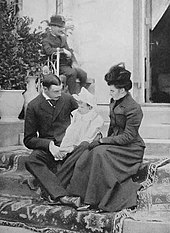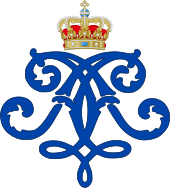Alexandrine of Mecklenburg-Schwerin
| Alexandrine of Mecklenburg-Schwerin | |
|---|---|
Queen consort of Iceland | |
| Tenure | 1 December 1918 – 17 June 1944 |
| Born | 24 December 1879 Neustadt Palace Schwerin, Grand Duchy of Mecklenburg-Schwerin, German Confederation |
| Died | 28 December 1952 (aged 73) Copenhagen, Denmark |
| Burial | |
| Spouse | |
Frederick Francis III, Grand Duke of Mecklenburg-Schwerin | |
| Mother | Grand Duchess Anastasia Mikhailovna of Russia |
| Signature | |
Alexandrine of Mecklenburg-Schwerin
Alexandrine was a daughter of
Alexandrine became
Early life
Birth and family

Alexandrine was born a

Duchess Alexandrine had two younger siblings: her only brother was
Childhood and early adulthood

After their father's succession as Grand Duke upon the death of his father on 15 April 1883, Alexandrine grew up with her brother and sister at the
First years in Denmark
Engagement and marriage


It was also in Cannes during the winter visit of 1897 that Duchess Alexandrine met her future husband, Prince Christian of Denmark, the eldest son of
The wedding of Duchess Alexandrine and Prince Christian was celebrated on 26 April 1898 in Cannes, when she was 18 years old.[1] They had two children:
- Prince Frederik (1899–1972), later King Frederik IX of Denmark; married Princess Ingrid of Sweden
- Prince Knud (1900–1976), later Knud, Hereditary Prince of Denmark; married Princess Caroline-Mathilde of Denmark
Early years in Denmark
Upon their arrival in Denmark, the couple were given
On 29 January 1906, her husband's grandfather King
Queen of Denmark


On 14 May 1912, King Frederik VIII died suddenly in Hamburg, Germany, while returning from a recuperation stay in Nice in Southern France. Alexandrine's husband acceded to the throne as Christian X, and Alexandrine became queen consort of Denmark.[1] She is not considered to have played any political role, but is described as being a loyal support to her spouse.
She was interested in music, and acted as the protector of the musical societies Musikforeningen i København and Den danske Richard Wagnerforening. She was known for her needlework, which she sold for charitable purposes. After the death of her mother-in-law Louise of Sweden in 1926, she succeeded her as the official protector of the various charity organisations founded by Louise. She enjoyed golf and photography.
During
She survived the
World War II


The couple was given great popularity as national symbols during the World War II occupation, which was demonstrated during a tour through the country in 1946. Before the occupation, she and her daughter-in-law were engaged in mobilising the Danish women.
Her rejection of Major General Kurt Himer, Chief of Staff to General Kaupisch on 9 April 1940 became a symbol for her loyalty toward Denmark before her birth country Germany.[7] When General Himer asked for an audience with the monarch, Christian was persuaded to receive him by his daughter-in-law as he would any other, which was supported by Alexandrine.[8] He asked to do so alone, but Alexandrine told him she would interrupt them. When the General was about to leave, she came in; and when he greeted her, she said: "General, this is not the circumstance in which I expected to greet a countryman."[8]
It was reported, that although Alexandrine was seen as shy and disliked official ceremonies, she had a "sharp" intelligence, and she was, together with her daughter-in-law, Ingrid of Sweden, a true support of the monarch and a driving force for the resistance toward the occupation within the royal house.[8] It was also reported, that in contrast to the monarch himself and the Crown Prince, the Queen and the Crown Princess never lost their calm when the nation was attacked.[8] As she was not the Head of the Royal House, she could show herself in public more than her spouse, who did not wish to show support to the occupation by being seen in public, and she used this to engage in various organisations for social relief to ease the difficulties caused by the occupation.[7] Kaj Munk is quoted to describe the public appreciation of her during World War II with his comment: "Protect our Queen, the only German we would like to keep!"[7]
Later life

In 1947, she was widowed; she became the first queen dowager of Denmark to opt not to use that title. In her later years, Alexandrine stayed longer and longer at Marselisborg Castle in Jutland. She remained very active until the end of her life, continuing her work as a patron and her charitable work;[9] she was also an avid golfer and photographer, and produced excellent needlework.
Queen Alexandrine died on December 28, 1952 after a long illness and was buried at the traditional burial place of the royal family in Roskilde Cathedral.
Titles, styles, honours and arms


Honours
National honours
- German Empire German Imperial and Royal Family: Dame of the Imperial and Royal Order of Louise, 1st Class
- Mecklenburg-Schwerin House of Mecklenburg-Schwerin: Knight Grand Cross of the Schwerin Royal House Order of the Wendish Crown, Special Class[10][11][12]
- Mecklenburg-Schwerin
- Denmark: Knight with Collar of the Order of the Elephant[13][14][15]
- Denmark: Knight Grand Commander of the Order of the Dannebrog[13][14][15]
- Denmark: Dame of the Royal Family Order of King Christian IX[16]
- Denmark: Dame of the Royal Family Order of King Frederik VIII
- Denmark: Dame of the
Foreign honours
- Iceland: Grand Cross of the Order of the Falcon
- Russian Empire Russian Imperial Family: Dame Grand Cordon of the Imperial Order of Saint Catherine
- Spain Spanish Royal Family: 1,170th Dame Grand Cross of the Royal Order of Queen Maria Luisa
- Sweden: Member of the Royal Order of the Seraphim[17]
- Sweden: Recipient of the 70th Birthday Badge Medal of King Gustaf V[18]
- Sweden: Recipient of the 90th Birthday Badge Medal of King Gustav V[15][17]
Ancestors
| Ancestors of Alexandrine of Mecklenburg-Schwerin | ||||||||||||||||||||||||||||||||||||||||||||||||||||||||||||||||||||||||||||||||||||||||||||||||||||||||||||||||||||||||||||||||||||||||||||||||||||||||||||||||||||||||||||||||||||||||||||||||||||||||||||||||||||||||||||||||||||||||||||
|---|---|---|---|---|---|---|---|---|---|---|---|---|---|---|---|---|---|---|---|---|---|---|---|---|---|---|---|---|---|---|---|---|---|---|---|---|---|---|---|---|---|---|---|---|---|---|---|---|---|---|---|---|---|---|---|---|---|---|---|---|---|---|---|---|---|---|---|---|---|---|---|---|---|---|---|---|---|---|---|---|---|---|---|---|---|---|---|---|---|---|---|---|---|---|---|---|---|---|---|---|---|---|---|---|---|---|---|---|---|---|---|---|---|---|---|---|---|---|---|---|---|---|---|---|---|---|---|---|---|---|---|---|---|---|---|---|---|---|---|---|---|---|---|---|---|---|---|---|---|---|---|---|---|---|---|---|---|---|---|---|---|---|---|---|---|---|---|---|---|---|---|---|---|---|---|---|---|---|---|---|---|---|---|---|---|---|---|---|---|---|---|---|---|---|---|---|---|---|---|---|---|---|---|---|---|---|---|---|---|---|---|---|---|---|---|---|---|---|---|---|---|---|---|---|---|---|---|---|---|---|---|---|---|---|---|---|
| ||||||||||||||||||||||||||||||||||||||||||||||||||||||||||||||||||||||||||||||||||||||||||||||||||||||||||||||||||||||||||||||||||||||||||||||||||||||||||||||||||||||||||||||||||||||||||||||||||||||||||||||||||||||||||||||||||||||||||||
Notes
References
Citations
- ^ a b c d e f g Engelstoft 1933, p. 239.
- ^ "Neustädtisches Palais". Residenzensemble Schwerin – Obtaining world cultural heritage. Retrieved 18 November 2021.
- ^ Zeepvat 2006, p. 5.
- ^ "The Grand Duke of Mecklenburg-Schwerin Shown to Have Committed Suicide" (PDF). The New York Times. 13 April 1897. Archived from the original on 3 February 2014. Retrieved 23 October 2007.
- ^ "The Grand Duke of Mecklenburg Schwerin Did Not Commit Suicide" (PDF). The New York Times. 15 April 1897. Archived from the original on 3 February 2014. Retrieved 23 October 2007.
- ^ Collier 1974.
- ^ a b c Börge Outze & Aage Svendstorp (in Swedish): 5 år i bojor. Danmark under ockupationen 1940–1945 (5 years in chains. Denmark during the occupation) Aktiebolaget boktryck (1945) Hälsingborg.
- ^ a b c d "3".
- ^ Busck, Jens: Christian 10. og Dronning Alexandrine. Biografie, herausgegeben vom Amalienborg-Museum. Kopenhagen 2012. ISBN 978-87-89542-98-0. S. 45, S. 47.
- ^ Image BP Blog
- ^ Alexandrine of Denmark Wikimedia
- ^ Wedding of Alexandrine of Denmark Wikimedia
- ^ a b c blogspot.com, Queen Alexandrine wearing her Danish decorations
- ^ a b c Flickr.com, Queen Alexandrine wearing her Danish Orders
- ^ a b c d Pinterest.com, Queen Alexandrine wearing decorations
- ^ Image BP Blog
- ^ a b Pinterest.com, Queen Alexandrine wearing the Seraphim Order and 90th birthday medal
- ^ "Archived copy". Archived from the original on 20 February 2018. Retrieved 25 April 2017.
{{cite web}}: CS1 maint: archived copy as title (link)
Bibliography
- Bramsen, Bo (1992). Huset Glücksborg. Europas svigerfader og hans efterslægt [The House of Glücksburg. The Father-in-law of Europe and his descendants] (in Danish) (2nd ed.). Copenhagen: Forlaget Forum. ISBN 87-553-1843-6.
- Engelstoft, Povl (1933). "Alexandrine" (PDF). Dansk Biografisk Leksikon (in Danish). 1 (2nd ed.). Copenhagen.
- Heiberg, Steffen, ed. (2000). Danske dronninger i tusind år (in Danish). ISBN 8700455040.
- Ilsøe, Grete (2000). "Alexandrine (1879-1952)". Dansk Kvindebiografisk Leksikon (in Danish). Copenhagen.
- Lerche, Anna; Mandal, Marcus (2003). A royal family : the story of Christian IX and his European descendants. Copenhagen: Aschehoug. ISBN 9788715109577.
- ISSN 1653-5219.
External links
- Queen Alexandrine at the website of the Amalienborg Palace

